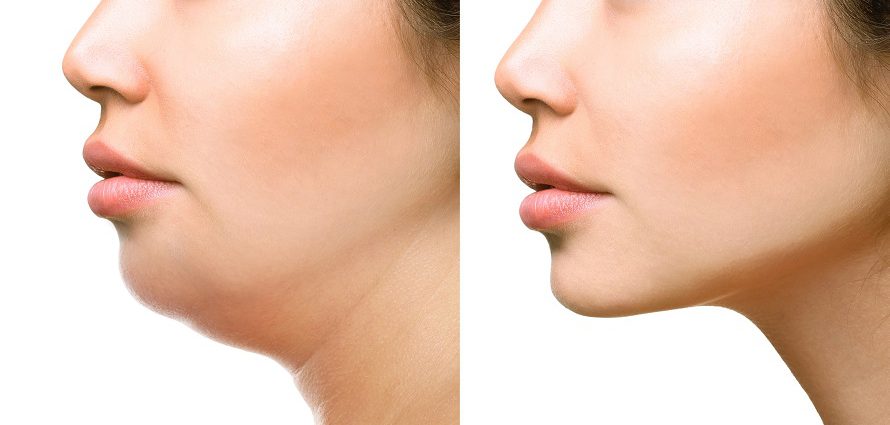Get Gorgeous Now with Facial Liposuction

Reviewed by Darrick E. Antell, MD
Liposuction is often associated with body contouring, but growing numbers of board-certified plastic surgeons are also achieving excellent results with facial liposuction. Commonly treated areas include the cheeks, chin, neckline and jawline.
Also referred to as submental or submentum liposuction, facial liposuction can be performed on its own or with other facial rejuvenation procedures such as a facelift, Botox or soft tissue filler injections.
As many people can attest, it is not easy to lose weight in your face. The chin and jaw areas are notoriously resistant to the effects of diet and exercise. Liposuction can create subtle improvements to these spots that result in a more slender facial profile.
If you are concerned that your cheeks are too puffy or chubby, your surgeon may recommend a cheek reduction procedure known as buccal fat reduction instead of facial liposuction.
Are You a Candidate for Facial Liposuction?
If you are troubled by a double chin, jowls or a turkey-waddle neck, facial liposuction may be an option. The best way to determine if facial liposuction is for you is to schedule a consultation with a board-certified plastic surgeon who has experience performing facial liposuction and/or other facial rejuvenation procedures. He or she will examine your facial anatomy and engage you in a candid discussion of your aesthetic goals and expectations.
Weight loss or gain may affect the results of your facial liposuction, so you should be at your ideal weight before considering the procedure. Tell your surgeon if you are planning to lose weight. Other lifestyle factors also may affect your candidacy. For example, smoking can impair healing and compromise the results of your surgery; If you smoke, tell your surgeon. Alcohol use may also increase facial liposuction risks. Certain over-the-counter (OTC) medications can increase bleeding risks and complicate your healing. Make sure you tell your surgeon about all medications you take on a regular basis, including dietary supplements.
Facial Liposuction: The Basics
Facial liposuction can be performed in less than an hour using light sedation plus a local anesthetic. If you are having other facial procedures performed simultaneously, general anesthesia may be warranted. This decision will be made together with your surgeon following a thorough consultation.
Facial liposuction is similar to liposuction on other areas of the body. The main difference is the amount of fat that is being removed. In general, just a few ounces of fat are removed from your face. By contrast, liposuction of the thighs may involve the removal of pounds of fat.
Your precise surgical plan will depend on what facial areas are being treated with liposuction. To treat the jowls or chin area, your surgeon will make a two- to four-centimeter incision beneath your chin or between your gums and the bottom of your inner lower lip. He or she will then insert a thin tube called a cannula, which is moved back and forth to break up the fat. The fat is then vacuumed out.
Some surgeons may use other liposuction technologies to emulsify the fat before it is removed. These can include ultrasound-assisted liposuction, power-assisted liposuction, laser-assisted liposuction or water-assisted liposuction. These techniques may allow for a gentler procedure. After the appropriate amount of fat is removed, your surgeon will close your incisions. Facial liposuction results are immediate.
Facial Liposuction Recovery
Your facial liposuction recovery process depends on whether or not you have other procedures performed at the same time. If facial liposuction is performed on its own, recovery is more straightforward. Expect some mild pain and discomfort, which can be controlled with OTC or prescription painkillers. Some swelling and bruising is also common. Wearing a compression garment for several weeks can help reduce any swelling.
You can likely return to work within five days or sooner if you can cover the treated area with a scarf or turtleneck garment. If the incisions are in your mouth, your diet may be restricted. Follow your surgeon’s postoperative instructions carefully to minimize your risk of complications.
Facial Liposuction Risks
No surgery is risk-free. Potential facial liposuction complications may include:
- Infection
- Bleeding
- Nerve damage, loss of sensation
- Scarring
- Dissatisfaction with the cosmetic results
- Anesthesia risks
- Hematoma (collection of blood pooling under the skin that may clot)
- Seroma (collection of fluid under the skin)
In general, the risks of facial liposuction are lower than those seen with liposuction of the body. Discuss the risks of facial liposuction with your surgeon before scheduling your surgery. He or she should provide important information on how to minimize them. Quitting smoking, for example, can reduce your risk of developing a postsurgical infection. Your surgeon may prescribe antibiotics to lower your risk of infection. Take the full course of these medications to make sure you are protected.
Facial Liposuction Cost
Facial Liposuction cost varies based on the areas being treated. Chin, cheeks, jowls and neck liposuction can cost anywhere from $2,500 to $5,000. Laser-assisted liposuction and ultrasound-assisted liposuction may increase these costs. Insurance rarely covers the cost of purely cosmetic procedures. Ask your doctor about financing options if the cost is more than you can afford at one time.
About the Reviewer of This Article
Darrick E. Antell, MD, is an educational spokesperson for the American Society of Plastic Surgeons. He is a board-certified plastic and reconstructive surgeon who has been in private practice for more than 20 years in New York City. Dr. Antell is a member of the American Society for Aesthetic Plastic Surgery and the American Society of Plastic Surgeons. He is also a Fellow of the American College of Surgeons. Dr. Antell received his general surgery training at Stanford University Medical Center and his specialty training in plastic/reconstructive surgery at the New York Hospital/Cornell Medical Center and the Memorial Sloan-Kettering Cancer Center in New York City.



